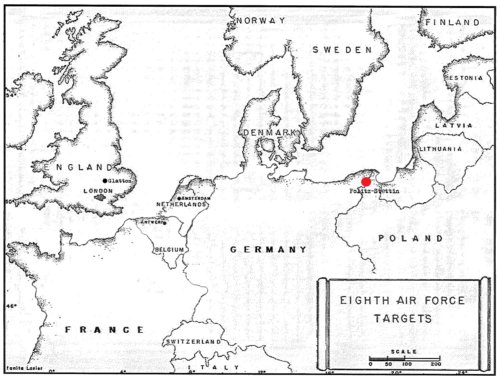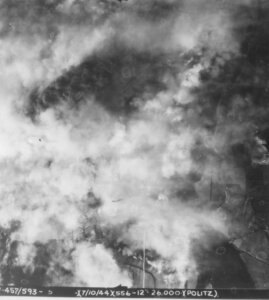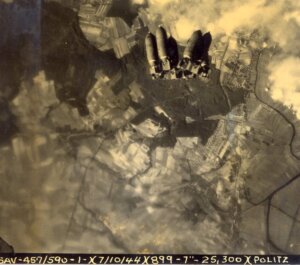TARGET: SYNTHETIC OIL PLANT
POLITZ, POLAND
7 OCTOBER, 1944

The mission would be one that would long live in the history of the Group. Although the synthetic oil plant at Politz, second largest of its type in Germany, had been attacked several times, it was again the target for the Group. The MPI assigned to the 457th was the distillation plant, which had not yet sustained much damage. Thirty-six aircraft made up the 94th A Combat Wing and twelve craft composed the D composite box. Col. Luper flew as Air Commander and Captain Fischer as pilot.
The Group was first in the Division formation and was the first of four groups in the 94th Combat Wing over this target. Other forces were sent up to attack other oil plants. The mission was a “max” effort with the three groups of the Wing putting up flight boxes of thirty-six planes each and then supplying twelve craft each to form the composite group.
The planes took off at 0700 hours with Col. Luper in the lead. After assembling, the Group flew the route over England on time and on course, and assumed its proper position at the Division assembly line.
Because of winds, the Group was about five minutes late reaching the English coast. Once over enemy territory, however, the formation was able to gain two minutes, arriving at the IP only three minutes late. The planned bomb run was eight minutes, and the bombing pattern called for the high and low boxes to bomb in trail on the lead box. The Rally Point was over the Stettin Bay and the North Sea, and return would be in formation. The Rally Point was designed to get the bombers out of antiaircraft gun range as quickly as possible.
The lead squadron made the turn onto the bomb run. Visibility was excellent, but the target area was covered by an artificial smoke screen made by the Germans, so that triangulation had to be used to locate the MPI. The lead craft made the majority of the bomb run, but was hit by intense, deadly, extremely accurate flak just before the BRL. The plane opened and then closed its bomb-bay doors just before the BRL, without releasing the bombs, apparently as a signal for the deputy to take over the lead.
Target Politz, Poland
Editor’s Note: In a conversation with a crewman flying the mission, it was indicated CoL Luper had closed the bomb bay doors and ordered a 360 degree turn just at the moment of impact of the first burst offlak
Editor’s note: I, flying as copilot on Spleth’s crew, was monitoring interplane radio. The only words from Luper were, “Get that goddam formation in here!” We were flying the “slot”, right under his tail. Gasoline, oil and flames were coming out of their wheel wells, and over the top of the No. 3 engine. They dropped straight down in front of us, and I didn’t see them any more.
The lead craft was hit in two engines. The fires spread, the craft was engulfed in flames, went into a steep dive and exploded. Seven chutes were observed. Six of the crew were killed in action
No. 3 craft, piloted by Lt. Clarence R. Jennings, was hit at approximately the same time, but salvoed its bombs. Lt. Jennings lost two engines on the bomb run; however, he was able to bring the plane under control and went to Sweden where the crew was interned. On board this craft was Captain Floyd A. Cox, Intelligence Officer for the 751st Squadron. Captain Cox, riding in the nose, had taken a portion of the flak that knocked out the engines and was killed. Lt. Stewart W. Jakku, the bombardier, also riding in the nose, was critically injured by the flak burst and later died
Lt Jennings lost all brakes during the flight and upon landing used the “throw the parachutes out the window” technique to slow the plane and bring it to a halt. Two other aircraft in the squadron, believing Lt. Jennings’ bombs to be the bombs of the lead craft, toggled. The deputy lead aircraft, piloted by Lt. Vernon M. Moland, also experienced difficulty when it was hit near the BRL. The plane began to lose altitude rapidly and salvoed its bombs. Although the plane took an almost direct hit in the nose, it did not go Out of control. The craft remained airborne for a period of time, long enough for the crew to bail out and survive.
After these episodes, the remaining six aircraft toggled. No sighting operation was performed.
The low squadron crossed the IP on course and found the same conditions existing over the target area. The bombs dropped from 24,800 feet and hit just short of the assigned MPI. The bombardier of the high box used triangulation to bomb through the smoke screen. The high box lead pilot, Captain Vinton H. Mays, was killed about one minute before the BRL. Intense and accurate flak interfered with the bomb run, but the bombs were released from 26,000 feet. Study of bomb bursts showing through the smoke indicated strikes just to the left of the assigned MPI.
The leader of the high flight in the lead squadron, Lt. J. F. Angier, assumed the lead of the Group, rallied the formation and led it on the return route. The planes landed with five aircraft missing.
The plane piloted by Lt. Ernest T. Saizer was in the low squadron of the D composite box, encountered mechanical prob lems and ditched in the North Sea. The entire crew was saved. The plane piloted by Lt. William H. Flannery in the lead of this squadron was hit by flak in No. 3 engine. The plane dove out of control and crashed near Politz. Five crewmen perished in the crash.
The low squadron, which flew with the 351st Group, attacked the primary target visually. The MPI was obscured by a smoke screen and the flak was intense and accurate. The lead squadron executed a 360 degree turn and the low squadron followed in trail. After crossing the IP, the lead squadron made a 90 degree turn to the right, but the low and high squadrons headed straight on and released their bombs. Flight altitude at this point was 26,000 feet. Just after bombs away, the lead craft (Flannery) of the low squadron was shot down.
In addition to the six planes lost, thirty-eight sustained some degree of battle damage, five having major damage.
The devastation was felt over the Base. Killed in the lead craft were the pilot, Captain Alfred W. Fischer, the Group Bombardier, Captain Henry P. Loades and the Group Flight Surgeon, Major Gordon H. Haggard. Additionally, the flight engineer, Sgt. John W. Koehler, Lt. Edward A. McNeal, and Sgt. Ancil V. Shepherd were also killed. The leader of Luper’s Super Troopers, Col. James Rhea Luper, who had led his troops into combat, was a prisoner of war for the duration.
Crew members retained two impressions-the anti aircraft shells at Politz were substantially larger than the usually expected 88 mm shells, and aiming had to be visual, as indicated by their uncanny accuracy in picking off lead aircraft.
(Ed. note: For an account of the mission to Politz on October 7 by Spleth’s crew, see DEAD ENGINE KiDS.)
The Group stood down awaiting a decision from Division and Wing on the new Group Commander. That selection was soon made and was Colonel Harris E. Rogner, who assumed command on 11 October, 1944. Col. Rogner was a graduate of the United States Military Academy, in the Class of 1938. He selected the Air Corps as his branch of service. He had been assigned to the 40 1st Bomb Group at Deenethorpe as Deputy Commander, and in April 1944, had been assigned as Deputy Commander of the 94th Combat Wing. Col. Rogner was no stranger to combat nor to the 45 7th. He had been Air Commander on some of the rough missions and had been awarded the Distinguished Flying Cross with two Oak Leaf Clusters and the Air Medal with two clusters. He came ready to go to work.
Col. Rogner’s official message to the personnel of the ‘ Station was as follows: “Combat operations prohi bit my taking your lime to call you together. I hope, in the near future, to become acquainted personally with each of you. I am extremely proud to be permitted to serve with the 457th Bomb Group, just as you are proud to be a member of it. Let s continue as the best Group in the European Theatre of Operations.”
Sgt. Albert G. Williams, 457th/751st gunner: Target was synthetic oil plant at Stettin. Intense FLAK. We lost Col. Luper, our CO, who was in P.F.F. ship – two ther P.F.F. ships went down. We came back with dozen holes in our ship, including one that came through the nose and hit our bombardier on the shoulder of his parachute harness. We almost ditched and landed at Polebrook by mistake – with #1 gas gauge reading 0 – and 20 gallons in the other three.
Lt. Edwin B. Benson, 457th/749th bombardier: Mission 13. Politz, Oil plant. Time 10.00. High. Dep. FLAK
